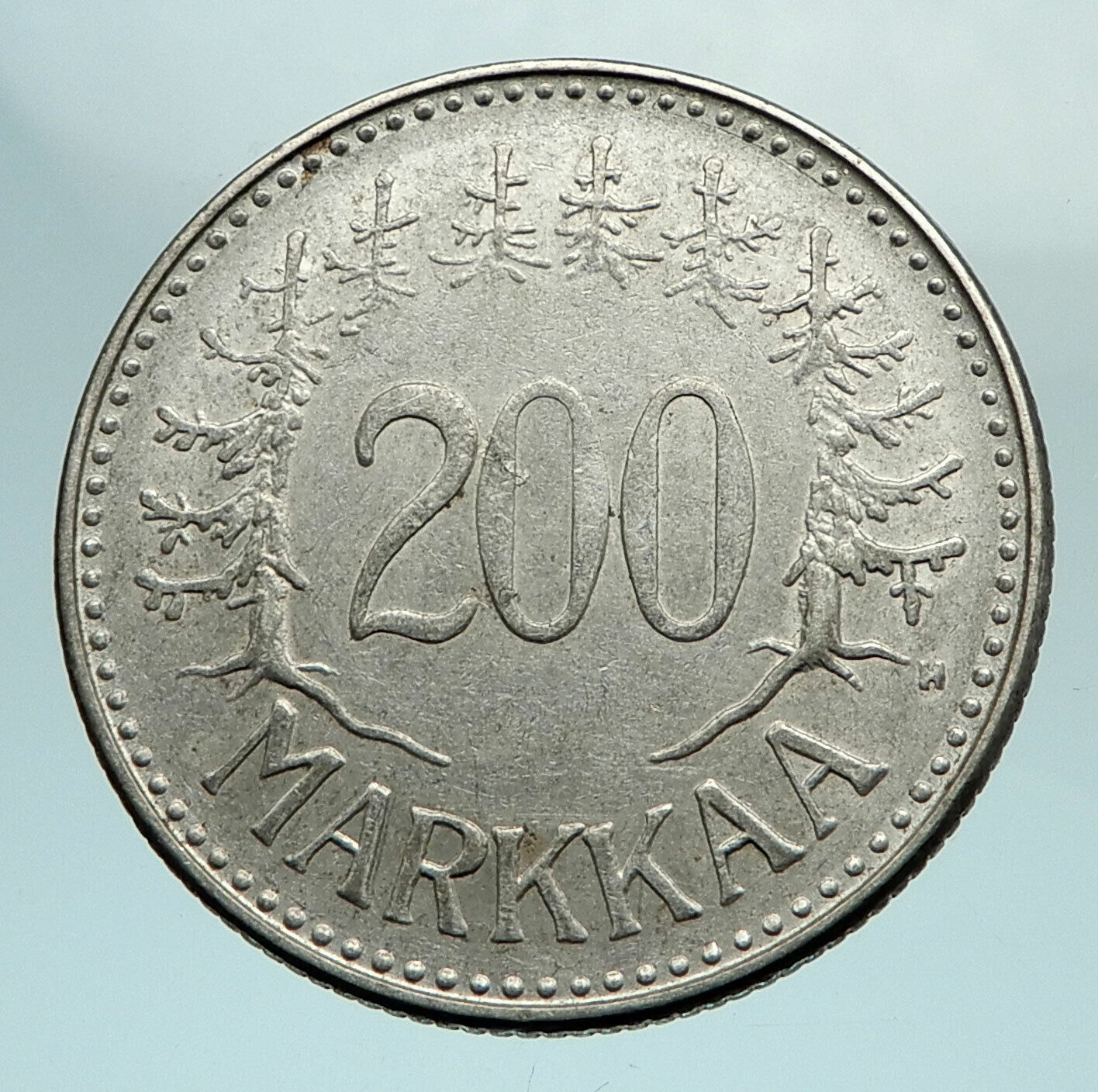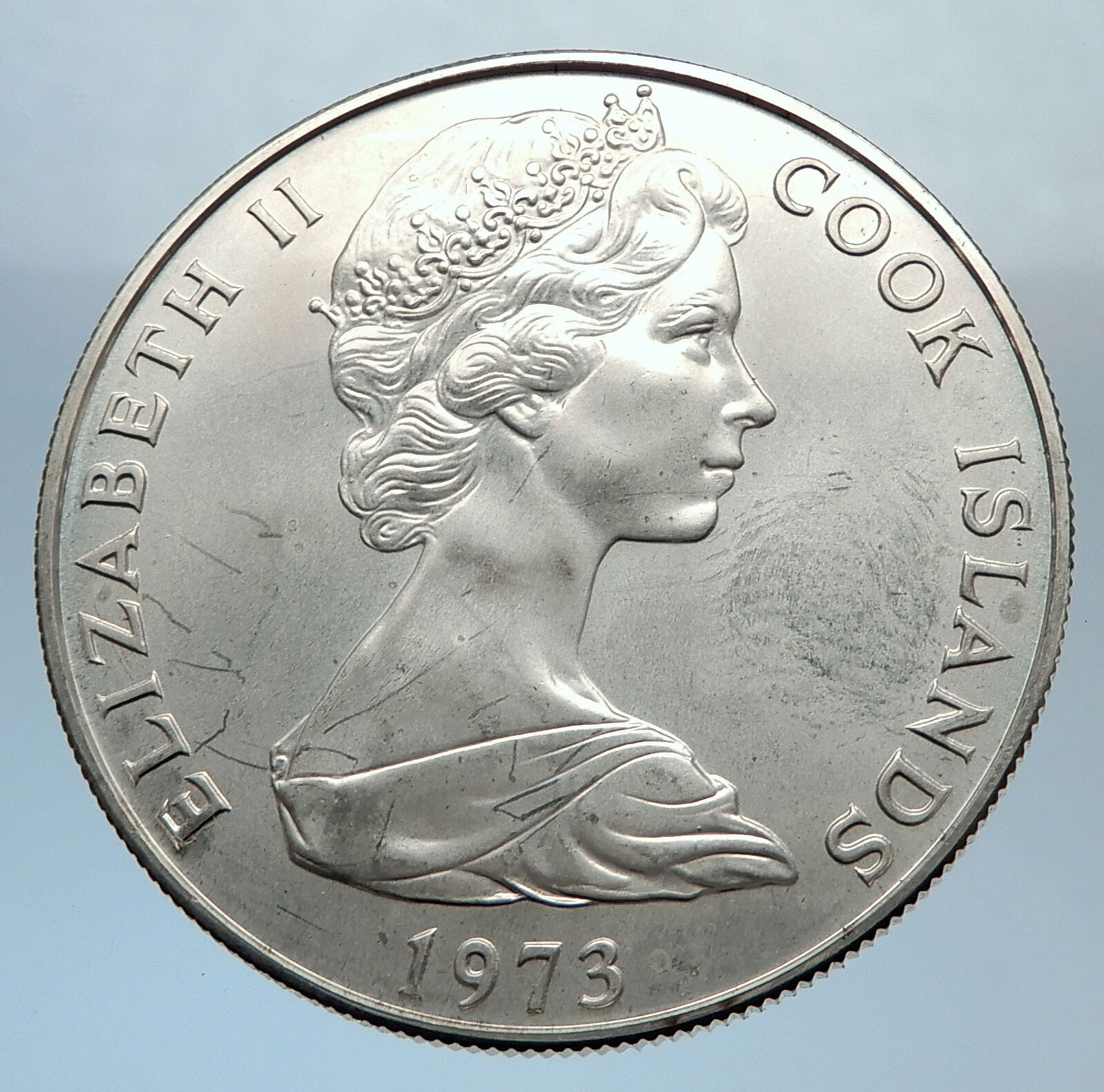|
Finland – Markka Currency System Centennial – Snellman
1960 Silver 1000 Markkaa 29mm (14.01 grams) 0.500 Silver (0.1929 oz. ASW)
Reference: KM# 43
SUOMEN TASAVALTA 1960, Head left, date below, legend surrounding.
1860 ∙ 4 ∙ 1960 IV 1000 MARKKAA S J, Denomination within wreath, legend surrounding.
You are bidding on the exact item pictured, provided with a Certificate of Authenticity and Lifetime Guarantee of Authenticity.
The Finnish markka (Finnish: Suomen markka, abbreviated mk, Swedish: finsk mark, currency code: FIM) was the currency of Finland from 1860 until 28 February 2002, when it ceased to be legal tender. The markka was replaced by the euro (€), which had been introduced, in cash form, on 1 January 2002, after a transitional period of three years when the euro was the official currency but only existed as ‘book money’. The dual circulation period – when both the Finnish markka and the euro had legal tender status – ended on 28 February 2002.
The markka was divided into 100 pennies (Finnish: penni, with numbers penniä, Swedish: penni), postfixed “p”. At the point of conversion, the rate was fixed at €1 = 5.94573 mk.
The markka was introduced in 1860 by the Bank of Finland, replacing the Russian ruble at a rate of four markkaa to one ruble. Senator Fabian Langenskiöld is called “father of markka”. In 1865 the markka was separated from the Russian ruble and tied to the value of silver. From 1878 to 1915, Finland adopted the gold standard of the Latin Monetary Union. Before markka there were Swedish riksdaler and Russian ruble used side-by-side for a time.
Up to World War 1, the value of the markka fluctuated within +23%/−16% of its initial value, but with no trend. However, the markka suffered heavy inflation (91%) during 1914-18. Gaining independence in 1917, Finland returned to the gold standard from 1926 to 1931. Prices remained stable until 1940. but the markka suffered heavy inflation (17% annually on average) during the war years and then up to 1926, and again in 1956-57 (11%). In 1963 the markka was replaced by the new markka, equivalent to 100 old markkaa.
Finland joined the Bretton Woods Agreement in 1948. The value of markka was pegged to the dollar at 320 mk/US$, which became 3.20 new mk/US$ in 1963 and devalued to 4.20 mk/US$ in 1967. After the breakdown of the Bretton Woods agreement in 1971, a basket of currencies became the new reference. Inflation was high (over 5%) during 1971-85. Occasionally, devaluation was used, 60% in total between 1975 and 1990, allowing the currency to more closely follow the depreciating US dollar than the rising German mark. The paper industry, which mainly traded in US dollars, was often blamed for demanding these devaluations to boost their exports. Various economic controls were removed and the market was gradually liberalized throughout the 1980s and the 1990s.
The monetary policy called “strong markka policy” (vahvan markan politiikka) was a characteristic feature of the 1980s and early 1990s. The main architect of this policy was President Mauno Koivisto, who opposed floating the currency and devaluations. As a result, the nominal value of markka was extremely high and in the year 1990, Finland was nominally the most expensive country in the world according to OECD’s Purchasing Power Parities report.
Koivisto’s policy was maintained only briefly after Esko Aho was elected Prime Minister. In 1991, the markka was pegged to the currency basket ECU, but the peg had to be withdrawn after two months with a devaluation of 12%. In 1992, Finland was hit by a severe recession, the Early 1990s depression in Finland. It was caused by several factors, the most severe being the incurring of debt, as the 1980s economic boom was based on debt. Also, the Soviet Union had collapsed, which brought an end to bilateral trade, and existing trade connections were severed. The most important source of export revenue, Western markets, were also depressed during the same time, in part due to the war in Kuwait. As a result, by some opinions years overdue, the artificial fixed exchange rate was abandoned and the markka was floated.[6] Its value immediately decreased 13% and the inflated nominal prices converged towards German levels. In total, the value of the markka had decreased 40% as a result of the recession. Also, as a result, several entrepreneurs who had borrowed money denominated in foreign currency suddenly faced insurmountable debt.
Inflation was low during the markka’s independent existence as a floating currency (1992-1999): 1.3% annually on average. The markka was added into the ERM system in 1996 and then became a fraction of the euro in 1999, with physical euro money arriving later in 2002. It has been speculated that if Finland had not joined the euro, market fluctuations such as the dot-com bubble would have reflected as wild fluctuations in the price of the markka. (Nokia, formerly traded in markkas, was in 2000 the European company with the highest market capitalization.)
Names
The name “markka” was based on a medieval unit of weight. Both “markka” and “penni” are similar to words used in Germany for that country’s former currency, based on the same roots as the German Mark and pfennig.
Although the word “markka” predates the currency by several centuries, the currency was established before being named “markka”. A competition was held for its name, and some of the other entries included “sataikko” (meaning “having a hundred parts”), “omena” (apple) and “suomo” (from “Suomi”, the Finnish name for Finland).
With numbers, Finnish does not use plurals but partitive singular forms: “10 markkaa” and “10 penniä” (the nominative is penni). In Swedish, the singular and plural forms of mark and penni are the same.
When the euro replaced the markka, mummonmarkka “grandma’s markka” (sometimes shortened to just mummo) became a new slang term for the old currency. The sometimes used “old markka” can be misleading, since it can also be used to refer to the pre-1963 markka.
In Helsinki slang, a hundred markkaa was traditionally called huge [hu.ge] (from Swedish hundra “hundred”). After the 1963 reform this name was used for one new markka.
 Finland, officially the Republic of Finland (Finnish: Suomen tasavalta, Swedish: Republiken Finland) is a country in Northern Europe bordering the Baltic Sea, Gulf of Bothnia, and Gulf of Finland, between Norway to the north, Sweden to the northwest, and Russia to the east. Finland is a Nordic country and is situated in the geographical region of Fennoscandia. The capital and the largest city is Helsinki. Finland, officially the Republic of Finland (Finnish: Suomen tasavalta, Swedish: Republiken Finland) is a country in Northern Europe bordering the Baltic Sea, Gulf of Bothnia, and Gulf of Finland, between Norway to the north, Sweden to the northwest, and Russia to the east. Finland is a Nordic country and is situated in the geographical region of Fennoscandia. The capital and the largest city is Helsinki.

Finland’s population is 5.5 million (2017), and the majority of the population is concentrated in the southern region. 88.7% of the population is Finnish and speaks Finnish, a Uralic language unrelated to the Scandinavian languages; next come the Finland-Swedes (5.3%). Finland is the eighth-largest country in Europe and the most sparsely populated country in the European Union. It is a parliamentary republic with a central government based in the capital city of Helsinki, local governments in 311 municipalities, and one autonomous region, the Åland Islands. Over 1.4 million people live in the Greater Helsinki metropolitan area, which produces one third of the country’s GDP.
Finland was inhabited when the last ice age ended, approximately 9000 BCE. The first settlers left behind artefacts that present characteristics shared with those found in Estonia, Russia, and Norway. The earliest people were hunter-gatherers, using stone tools. The first pottery appeared in 5200 BCE, when the Comb Ceramic culture was introduced. The arrival of the Corded Ware culture in southern coastal Finland between 3000 and 2500 BCE may have coincided with the start of agriculture. The Bronze Age and Iron Age were characterised by extensive contacts with other cultures in the Fennoscandian and Baltic regions and the sedentary farming inhabitation increased towards the end of Iron Age. At the time Finland had three main cultural areas – Southwest Finland, Tavastia and Karelia – as reflected in contemporary jewellery.
.svg/220px-EU-Finland_(orthographic_projection).svg.png)
From the late 13th century, Finland gradually became an integral part of Sweden through the Northern Crusades and the Swedish part-colonisation of coastal Finland, a legacy reflected in the prevalence of the Swedish language and its official status. In 1809, Finland was incorporated into the Russian Empire as the autonomous Grand Duchy of Finland. In 1906, Finland became the first European state to grant all adult citizens the right to vote, and the first in the world to give all adult citizens the right to run for public office.
Following the 1917 Russian Revolution, Finland declared itself independent. In 1918, the fledgling state was divided by civil war, with the Bolshevik-leaning Red Guard supported by the equally new Soviet Russia, fighting the White Guard, supported by the German Empire. After a brief attempt to establish a kingdom, the country became a republic. During World War II, the Soviet Union sought repeatedly to occupy Finland, with Finland losing parts of Karelia, Salla, Kuusamo, Petsamo and some islands, but retaining independence.
Finland joined the United Nations in 1955 and established an official policy of neutrality. The Finno-Soviet Treaty of 1948 gave the Soviet Union some leverage in Finnish domestic politics during the Cold War era. Finland joined the OECD in 1969, the NATO Partnership for Peace in 1994, the European Union in 1995, the Euro-Atlantic Partnership Council in 1997,[19] and finally the Eurozone at its inception, in 1999.
Finland was a relative latecomer to industrialisation, remaining a largely agrarian country until the 1950s. After World War II, the Soviet Union demanded war reparations from Finland not only in money but also in material, such as ships and machinery. This forced Finland to industrialise. It rapidly developed an advanced economy while building an extensive welfare state based on the Nordic model, resulting in widespread prosperity and one of the highest per capita incomes in the world. Finland is a top performer in numerous metrics of national performance, including education, economic competitiveness, civil liberties, quality of life, and human development. In 2015, Finland was ranked first in the World Human Capital and the Press Freedom Index and as the most stable country in the world during 2011-2016 in the Fragile States Index, and second in the Global Gender Gap Report. A large majority of Finns are members of the Evangelical Lutheran Church, and freedom of religion is guaranteed under the Finnish Constitution.
|





 Finland, officially the Republic of Finland (Finnish: Suomen tasavalta, Swedish: Republiken Finland) is a country in Northern Europe bordering the Baltic Sea, Gulf of Bothnia, and Gulf of Finland, between Norway to the north, Sweden to the northwest, and Russia to the east. Finland is a Nordic country and is situated in the geographical region of Fennoscandia. The capital and the largest city is Helsinki.
Finland, officially the Republic of Finland (Finnish: Suomen tasavalta, Swedish: Republiken Finland) is a country in Northern Europe bordering the Baltic Sea, Gulf of Bothnia, and Gulf of Finland, between Norway to the north, Sweden to the northwest, and Russia to the east. Finland is a Nordic country and is situated in the geographical region of Fennoscandia. The capital and the largest city is Helsinki. 
.svg/220px-EU-Finland_(orthographic_projection).svg.png)





